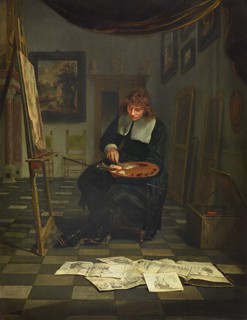Release Date: September 13, 2016
Major Exhibition Reveals Importance of Drawings to Paintings of the Dutch Golden Age

Michiel van Musscher, An Artist in His Studio with His Drawings, mid-1660s
oil on panel
Liechtenstein. The Princely Collections, Vaduz-Vienna
Washington, DC—With their vivid details and realistic nature, 17th-century Dutch landscapes, still lifes, and genre scenes seem to have been painted from life. In fact, most artists based their paintings on preliminary drawings. Drawings for Paintings in the Age of Rembrandt, on view in the West Building from October 4, 2016, through January 2, 2017, will shed light on the varied ways in which renowned artists of the Dutch golden age—including Rembrandt van Rijn, Aelbert Cuyp, Jacob van Ruisdael, and Pieter Jansz Saenredam—used drawings as part of the painting process.
The exhibition features nearly 100 such drawings, many of them paired with related paintings. Among the drawings are sheets from sketchbooks, rapidly executed compositional designs, detailed figure studies, and carefully rendered construction drawings made with the aid of a ruler and compass. The exhibition includes artists from throughout the 17th century and explores a wide variety of subjects, including depictions of everyday life, landscapes, architectural studies, portraits, still lifes, and history scenes. Underdrawings that artists made on their panels prior to painting are examined with the aid of infrared reflectography.
"We are thrilled to present an exhibition that contributes a new perspective to the scholarship on 17th-century Dutch art while also providing visitors with a better understanding of these masters and their artistic processes," said Earl A. Powell III, director, National Gallery of Art, Washington. "We are very grateful to Dr. Mihael and Mrs. Mahy Polymeropoulos and the Exhibition Circle for their generous support."
Exhibition Organization and Support
The exhibition is organized by the National Gallery of Art, Washington, and the Fondation Custodia, Collection Frits Lugt, Paris, where it will be on view from February 3 to May 7, 2017.
The exhibition is made possible through the generous support of Dr. Mihael and Mrs. Mahy Polymeropoulos. Additional funding is provided by The Exhibition Circle of the National Gallery of Art.
Exhibition Highlights
Drawing formed the basis of rigorous studio training for aspiring painters. Young artists started by copying prints and drawings, then paintings and sculptures; before progressing to making studies after live models and from nature. After this training, artists continued to draw throughout their careers and often used these drawings as guides for their painted compositions. Dutch drawings of the 17th century range from careful life studies to images drawn from the imagination, such as those based on stories from the Bible or mythology. For example, Jan van Kessel traveled through the Netherlands to record his impressions of the landscape in a sketchbook; Rembrandt made figure studies to resolve specific poses or groupings in his biblical paintings; and Saenredam made ruled construction drawings that he carefully transferred to panel before painting his soaring church interiors.
The drawings in the exhibition also reflect the range of materials artists used—pen and ink to quickly capture an idea or delineate a detail; chalk to model figures with tone, light, and shade; and watercolor to convey color. Counterproofs, made by pressing a moist paper onto a chalk drawing to obtain its reverse image, provided artists such as Gerrit Berckheyde with a greater variety of pictorial elements for painted compositions.
Several works in the exhibition will be on view in the United States for the first time, including Saenredam's drawing of the Choir and High Altar of Sint-Janskerk at 's-Hertogenbosch (1632) on loan from the British Museum, a preliminary study that the artist later used to create his oil on panel Cathedral of Saint John at 's-Hertogenbosch (1646) from the National Gallery of Art. Two of nine surviving sketchbooks by 17th-century Dutch draftsmen are included in this exhibition. Jan van Kessel's sketchbook will be displayed next to a touch-screen monitor with a digitized selection of its drawings.
Curator and Catalog
The exhibition and catalog are the result of a close collaboration among Peter Schatborn, former head of the Rijksprentenkabinet, Amsterdam, who proposed the concept; Ger Luijten, director of the Fondation Custodia, Collection Frits Lugt, Paris; and Arthur K. Wheelock, Jr., curator of northern baroque paintings at the National Gallery of Art, Washington.
A fully illustrated catalog features scholarly essays by the curators as well as entries by a team of international scholars on the artists and works included in the exhibition.
Press Contact:
Isabella Bulkeley, (202) 842-6864 or [email protected]
General Information
Department of Communications
National Gallery of Art
2000 South Club Drive
Landover, MD 20785
phone: (202) 842-6353
e-mail: [email protected]
NEWSLETTERS:
The Gallery also offers a broad range of newsletters for various interests. Follow this link to view the complete list.
Exhibition Press Release
Exhibition Checklist (PDF 286 kb)
National Gallery of Art Acquires Caspar Netscher's Masterpiece A Woman Feeding a Parrot, with a Page
Exhibition Page:
Drawings for Paintings in the Age of Rembrandt
Isabella Bulkeley
(202) 842-6864
[email protected]